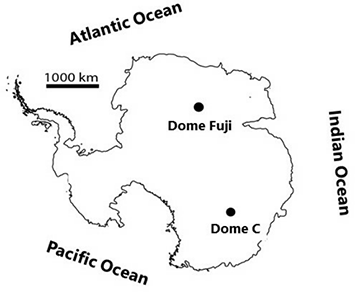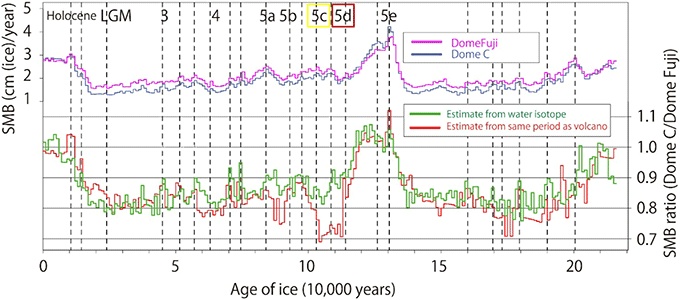National Institute of Polar Research
Determination of precise ratio of surface mass balance between two dome summit sites at Dome Fuji and Dome C in Antarctica
Released on February 8, 2017 (in Japanese)
Posted on May 2, 2017
National Institute of Polar Research
Atmosphere and Ocean Research Institute, the University of Tokyo
Japan Agency for Marine-Earth Science and Technology
University of the Ryukyus
Scientists clarified ratio of surface mass balance (SMB ratio) between two remote dome sites in Antarctica at Dome Fuji and Dome C, based on synchronization (matching the same events) of signals of deep ice cores drilled at these two sites. The new method of derivation gave precise estimation of the SMB ratio. The new information is useful for better understanding the spatial distribution of precipitation in Antarctica in the glacial and interglacial cycles and thus climatic changes.

Figure 1: Location of Dome Fuji and Dome C on the Antarctic ice sheet and in relationship to the surrounding oceans. Dome Fuji and Dome C are about 2,000 kilometers apart.
A research group lead by Shuji Fujita, Associate Professor of the National Institute of Polar Research, compared detailed stratigraphy of two deep ice cores drilled at Dome Fuji and Dome C, which are remote with each other by about 2,000 km on the Antarctic continent. In the ice, they identified 1,401 pairs of signals from common volcanic eruptions, covering the past 216,000 years. As a result of synchronization (matching the same events), they succeeded in determining ratio of surface mass balance (SMB ratio) between the two points with high precision.
The Antarctic continent and Greenland are covered by ice sheets that have grew by accumulating snowfall over several hundred thousands of years. The ice cores obtained by drilling in the ice sheet are an important resource for learning about the past Earth environment. In ice core research, understanding the SMB (annual snow accumulation (cm/year)) is essential. To date, the SMB has been inferred indirectly from the oxygen or deuterium ratio in water in the ice cores, but there was no means for verifying the degree of uncertainty in this estimate.
According to the research by the research group, the SMB ratio developed from volcanic synchronization tended to agree with the SMB ratio inferred from the deuterium ratio in water. However, they discovered discrepancies, in particular, of about 20% in the period from 106,000 to 115,000 years ago, known as marine isotope stage (MIS) 5d. This fact means that the method using a deuterium has a maximum uncertainty of about 20% in this period. In addition, this fact indicated that in MIS 5d, SMB changed dynamically in terms of spatial distribution and its temporal changes.
Furthermore, during the current interglacial period (Holocene: from about 10,000 years ago to the present), the SMB ratio determined by volcanic synchronization has been stable within a range of ±1%. This fact means that the SMB pattern has been stable both temporally and spatially. In addition, in the interior areas of Antarctica, it was clarified that the thickness of the ice sheet has been steadily increasing over the past ca.15,000 years.

Figure 2: (Upper graph) Values of SMB inferred from deuterium ratios in the Dome Fuji ice core and Dome C ice core. (Lower graph) Red: SMB ratio between two sites based on the volcanic synchronization. Green: SMB ratio between two sites inferred from deuterium ratios. Based on volcanic synchronization and deuterium, there is a discrepancy of about 20% at the MIS 5d (about 100,000 years to 110,000 years ago) and about 10% at the MIS 5c (93,000 years to 106,000 years ago).
Fujita commented that "in research using ice cores, the SMB is very basic information for analysis. With these results, we can improve reliability of various research, such as dating of ice cores." Furthermore, he added that "if we can explain the variation in the SMB in more detail, we can understand the local distribution of precipitation on the Antarctic ice sheet and how it is related to historical changes of ice sheet."
Published Paper
Journal: Journal of Glaciology (2016), 62(236) 1037–1048
Title: Climate dependent contrast in surface mass balance in East Antarctica over the past 216 ka
Authors:
F. Parrenin1,2, S. Fujita3,4, A. Abe-Ouchi5,6, K. Kawamura3,4, V. Masson-Delmotte7, H. Motoyama3,4, F. Saito6, M. Severi8, B. Stenni9, R. Uemura10, E. W. Wolff11
1 CNRS, LGGE, F-38041 Grenoble, France
2 University Grenoble Alpes, LGGE, F-38041 Grenoble, France
3 National Institute of Polar Research, Japan
4 Department of Polar Science, The Graduate University for Advanced Studies (SOKENDAI), Japan
5 Atmosphere and Ocean Research Institute (AORI), University of Tokyo, Japan
6 Japan Agency for Marine-Earth Science and Technology, Japan
7 Laboratoire des Sciences du Climat et de l'Environnement, Institut Pierre Simon Laplace, France
8 Department of Chemistry, University of Florence, Italy
9 Department of Environmental Sciences, Informatics and Statistics, Ca’ Foscari University Venice, Italy
10 Department Chemistry, Biology and Marine Science, Faculty of Science, University of the Ryukyus, Japan
11 Department of Earth Sciences, University of Cambridge, UK
Available online: August 1, 2016
URL:https://doi.org/10.1017/jog.2016.85
DOI:10.1017/jog.2016.85
Funder
This study was supported by JSPS Grant-in-Aid for Scientific Research (20241007, 21671001).
Contact
Public Relations Section, National Institute of Polar Research
E-mail: kofositu@nipr.ac.jp








